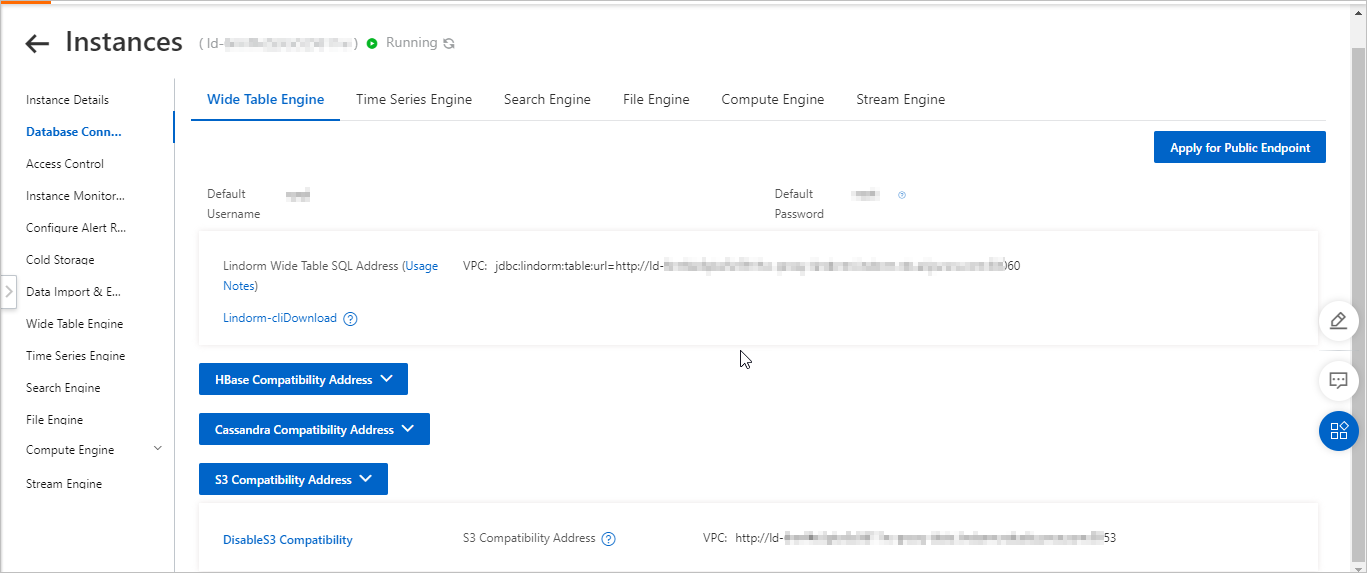This topic describes how to use Amazon S3 SDK for a non-Java language such as Go or Python to connect to and use LindormTable based on the Amazon S3 protocol and provides corresponding examples.
Prerequisites
An endpoint that corresponds to S3 Compatibility Address on the Wide Table Engine tab in the Lindorm console is obtained. For more information, see View endpoints.

The IP address of your client is added to the whitelist of your Lindorm instance. For more information, see Configure whitelists.
Procedure
Use Amazon S3 SDK for Go to connect to and use LindormTable
Install Amazon S3 SDK for Go.
go get github.com/aws/aws-sdk-goUse Amazon S3 SDK for Go to connect to and use LindormTable.
package main import ( "log" "strings" "github.com/aws/aws-sdk-go/aws" "github.com/aws/aws-sdk-go/aws/credentials" "github.com/aws/aws-sdk-go/aws/session" "github.com/aws/aws-sdk-go/service/s3" ) const ( s3endpoint = "http://ld-bp17j28j2y7pm****-proxy-lindorm.lindorm.rds.aliyuncs.com:9053" // Specify the endpoint that corresponds to S3 Compatibility Address on the Wide Table Engine tab. ) func main() { conf := &aws.Config{ Credentials: credentials.NewStaticCredentials("AK", "SK", ""), Region: aws.String("lindorm"), Endpoint: aws.String(s3endpoint), S3ForcePathStyle: aws.Bool(true), } sess, err := session.NewSession(conf) // Establish a connection. svc := s3.New(sess) // List all buckets. input := &s3.ListBucketsInput{} result, err := svc.ListBuckets(input) if err != nil { panic(err.Error()) } println(result.String()) bucket := "testbucketgo" key := "testObjectGo" // Create a bucket. out, err := svc.CreateBucket(&s3.CreateBucketInput{Bucket: &bucket}) log.Println(out) if err != nil { log.Println("Failed to create bucket", err) return } if err = svc.WaitUntilBucketExists(&s3.HeadBucketInput{Bucket: &bucket}); err != nil { log.Printf("Failed to wait for bucket to exist %s, %s\n", bucket, err) return } // Write an object to the bucket. _, err = svc.PutObject(&s3.PutObjectInput{ Body: strings.NewReader("Hello World!"), Bucket: &bucket, Key: &key, }) if err != nil { log.Printf("Failed to upload data to %s/%s, %s\n", bucket, key, err) return } }NoteReplace the AK and SK fields in the sample code with the AccessKey ID and AccessKey secret that you actually use to connect LindormTable. We recommend that you configure the AccessKey ID and AccessKey secret as environment variables or specify them in the configuration file rather than hardcoding them.
Use Amazon S3 SDK for Python to connect to and use LindormTable
Install Amazon S3 SDK for Python.
pip install boto3Use Amazon S3 SDK for Python to connect to and use LindormTable.
import boto3 from botocore.client import Config s3endpoint = 'http://ld-bp17j28j2y7pm****-proxy-lindorm.lindorm.rds.aliyuncs.com:9053' # Specify the endpoint that corresponds to S3 Compatibility Address on the Wide Table Engine tab. # Establish a connection. s3client = boto3.client( 's3', aws_access_key_id="AK", aws_secret_access_key="SK", endpoint_url = s3endpoint, config=Config(s3={'addressing_style': 'path'}) ) # Create a bucket. s3client.create_bucket(Bucket="testbucketpython") # List all buckets. buckets = s3client.list_buckets() # Display all buckets. for bucket in buckets['Buckets']: print(bucket["Name"]) # Upload an object. response = s3client.upload_file("demo.py", "testbucketpython", "demo.py") # Download the object. s3client.download_file('testbucketpython', 'demo.py', 'demo.py.download')NoteReplace the AK and SK fields in the sample code with the AccessKey ID and AccessKey secret that you actually use to connect LindormTable. We recommend that you configure the AccessKey ID and AccessKey secret as environment variables or specify them in the configuration file rather than hardcoding them.